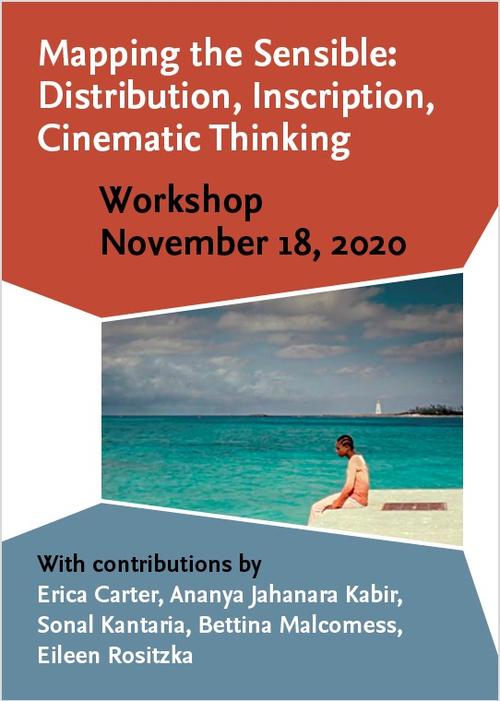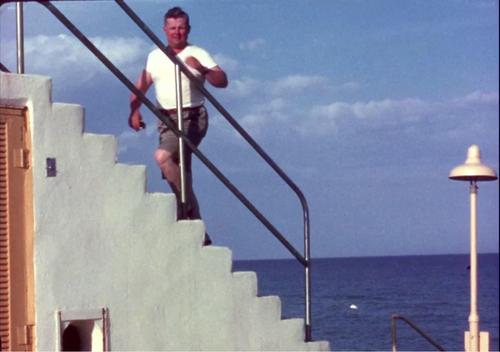Mapping the Sensible: Distribution, Inscription, Cinematic Thinking
18.11.2020 | Digital workshop by the Cinepoetics group with Erica Carter, Bettina Malcomess and Eileen Rositzka.
Research Focus: Digital Material and Essayistic Method
In the context of an upcoming contribution to the Cinepoetics Essay Series co-authored by Erica Carter, Bettina Malcomess, and Eileen Rositzka, the workshop focused on the rethinking of mapping in relation to audiovisual images and cultures as an experiential practice. Within the threefold discursive framework of cinematic thinking, distribution, and inscription, the presentations and discussions drew on a variety of aesthetic forms to explore the poetic and historico-political dimensions of mapping the sensible.
The first presentation by Erica Carter explored the colonial distribution of the sensible through the lens of the home movie. As a resource for imperial visual cartographies, the amateur travel film enables an understanding of mapping as embodied mobility. Drawing primarily on Bahamas and Florida (USA 1950; Prelinger Archives, San Francisco), Carter used the visual mappings of the travel film to trace the mobility of a white American couple. As a performative practice of situating oneself in often racialised surroundings, this amateur travel film was analysed as a point of aggregation of visual forms and genres through which a colonial image space is navigated.
In her talk about archives and repertoires of creolised mobilities, Ananya Jahanara Kabir presented her work on the mapping of global routes and cultural exchanges of different dance forms. She analysed dance as a way of tracing the entangled kinetic heritage of modernity, focusing on creolisation as a method of thinking cultural production. Her presentation explored the difficulties tied to the translation of movement into narrative and visual forms, forging an epistemological gateway of creating maps of nonlinear time. Furthermore, Kabir expounded the challenges of turning this vast research into a mobile app.
Drawing on her own experiences and the migratory history of her family, Sonal Kantaria examined the experience of Indian diaspora through an analysis of visual culture. She discussed her own photographic work as well as the cinematographic oeuvre of Zarina Bhimji to argue for a dialectic of placement and displacement as both a spatial and temporal category. Within this conception, the image featured as an arena of rifts and breaks, a nexus of traces of structural links between history, memory, and fantasy. The presentation was followed by a discussion about the sense of commonality carried by these images as well as the notion of global patterns made possible through the mapping of visual materials.
In her talk about the methods of visual mapping during the South African Civil War, Bettina Malcomess analysed the aesthetic dimensions of the technologies of inscription used during the war. As catalysts of visibility and legibility, these devices enable a form of ‘writing the battlefield’ by creating intelligible inscriptions that mediate and facilitate experience. To build and illustrate her argument, she used archival documents, most notably journals and diaries, to capture the way in which these media were employed as means of mapping an imperial vision of territory.
In the final session, Eileen Rositzka continued the thematic strand of war and territory. In her presentation on the cinematic thinking of the imaginary landscape in W. G. Sebald's novel The Rings of Saturn (1995) and its mediation in Grant Gee’s Patience (After Sebald) (UK 2012), she reflected on the capacities of the essayistic form to place the viewer within a subjective thinking process that draws on a web of interrelations while highlighting the performativity of language through images. It is the film's capacity to trace embeddedness, to conjoin multiple temporalities, i.e. to map the imaginary through the sensible that interested her in the context of post-war fiction. Cinematic thinking was hereby conceived of as a mode of reflection that provides a visual framework for the mapping of history from the periphery of individual experience.


